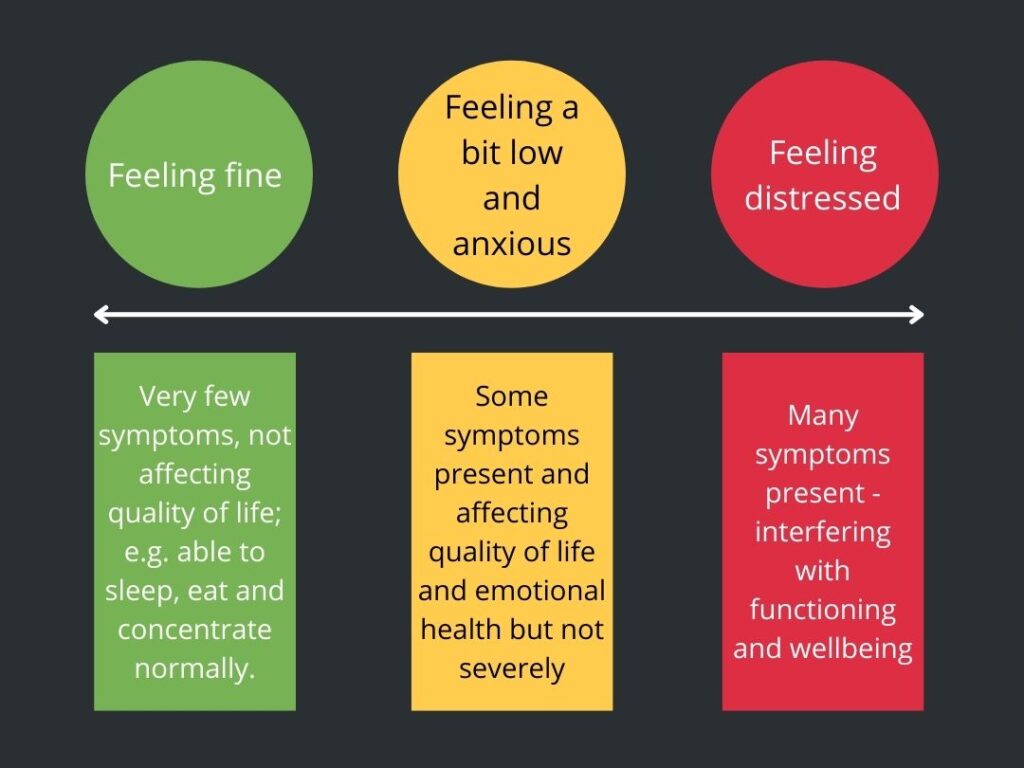This was me in 2016. I was working in a Sexual Assault Referral Centre at the time. A morning at work began with a staff meeting where we ran through the referrals that had come in overnight, we would hear five to six harrowing stories of assault before starting our clinical work. So those working hours were filled with indirect exposure to sexual trauma. What I noticed most at this time was the impact on my world-view, which became skewed towards a belief that men were dangerous and that bad things happen to people, hence becoming so wary on my evenings out. This was vicarious trauma.
What is Vicarious Trauma?
Vicarious trauma is an occupational hazard for any helping professional who empathically engages with traumatised people.
It is the negative psychological impact of working with traumatised individuals caused by a shift in world-view [i] for example, fearing for one’s own safety or distrusting others, leading to symptoms that mirror post-traumatic stress.
Terms that are often used interchangeably with vicarious trauma include: compassion fatigue, burnout, secondary trauma and critical incident stress.
Symptoms of vicarious trauma
There are three areas in which signs of vicarious trauma can present themselves [ii] :
- Physiological signs
- Insomnia
- Headaches
- Lower immunity (getting colds and other illnesses)
- Exhaustion
- Muscle ache and skin rashes
- Palpitations
- Behavioural signs
- Increased use of alcohol, drugs or emotional eating
- Irritability
- Avoidance of socialising or sexual intimacy
- Avoidance of work-based activities or the opposite, over-checking emails and staying late at work.
- Decision-making difficulties
- Increased off-loading/gossiping with colleagues at work
- Avoidance of non-work-related activities
- Hypervigilance (being watchful for signs of danger e.g. checking phone or scanning rooms for escape routes)
- Avoiding TV or media stories with trauma
- Emotional signs
- Anxiety, low mood or anger
- Feeling helpless, hopeless or guilty
- Persistent sense of dread, especially at work (e.g. going into meetings or meeting a new client)
- Feeling emotionally numb or empathically disengaged
- Dissociation i.e. mentally switching off or spacing out for short periods of time.
- Intrusive thoughts or images of the trauma you’ve heard
How does vicarious trauma affect work?
Aside from the negative impact on your emotional and physical health, if left unaddressed vicarious trauma can lead to diminished job satisfaction and efficacy at work.
Below are the three areas to look for signs at work. This is helpful for further spotting signs in yourself but also for noticing signs in co-workers or supervisees.
- Performance: If your mood is low this may start to impact on your motivation for some tasks (or even for turning up to work on time) . It could also affect your concentration and therefore make you more forgetful. Equally, high anxiety impacts on both avoidance of tasks, or the opposite – perfectionism (e.g. re-reading emails or over-preparing).
- Morale: It’s easy to see how the above impacts on moral. This can show up as imposter syndrome or apathy. The helplessness can lead to apathy and disinterest, feeling under-appreciated and ultimately this can impact on your connection with compassion.
- Work relationships: It’s typical to become withdrawn at times like this, avoiding coffee breaks with colleagues for example or miscommunicating with each other (especially if others are all in the same boat). We can become less patient and struggle to delegate.
Risk factors for vicarious trauma
There are factors [iii] that can increase the likelihood of suffering from vicarious trauma.
For example, if you’ve suffered from a trauma in your personal history then you will be more likely to be adversely affected.
A higher number of clinical hours (i.e. more exposure to traumatic material) also puts you at high risk.
There is also evidence that the type of trauma you are exposed to affects the likelihood of more severe symptoms. Working with sexual violence and adult survivors of sexual abuse carries the highest risk.
Finally, if your team and work culture is not trauma-informed then you will be less protected. So, if you are applying for jobs in high-risk fields ask how the organisation safeguards staff from vicarious trauma.
The good news is that despite these risk factors there are things that you can do to look after yourself and ways that organisations can look after their staff.
How to prevent vicarious trauma
What can you do to look after yourself when working in a setting that exposes you to indirect trauma?
Firstly, familiarise yourself with the signs and symptoms of vicarious trauma. It’s helpful to think about this as a continuum rather than in black or white (“I either have it or I don’t”) terms. Using this continuum below think about what each part of the scale looks like for you:

Some of the things that can be really helpful for keeping yourself in the “green” zone are:
Ensuring you are tending to your basic human needs such as rest, nutrition, exercise and connection with people you care about. So often these things drop down the priority list when our emotional health is rocky or we are busy. Who or what can help you get back on track with these things if they’ve fallen by the wayside? Hobbies and mindfulness meditations would be the next thing to focus on if your basics are already in place.
It’s also important to find a ritual [iv] that will help you switch off from work at the end of the day, such as walking home and listening to an uplifting playlist; doing yoga stretches or going for a short jog.
Tap into imagery that makes you feel safe and protected when you’re in work mode, and cared-for when in non-work mode. Spend some time developing an image and practice bringing it to mind when you aren’t stressed. This will help you to bring it to mind when you need it most. Ideas include your favourite place in nature, a nurturing person in your life and a personal achievement.
When you are edging up the amber and into the red zone consider what this looks like for you. For example, are you someone who starts to avoid tasks or the opposite; starts to overwork? Do you tend to emotionally eat or do you lose your appetite? It can be hard to see it at the time so investing a bit of time after reading this blog to identify your personal symptoms may help you to be alert to it.
Next, take time to ask yourself what your needs are when you are in the amber and red zones. If possible make some plans for this. If you start to edge up the continuum then you can put in more strategies to manage your symptoms. For example, reading this blog on grounding.
Think about what is within your control at work and start with managing this. For example, have you used the supervision options available to you or can you speak to your manager to set this up if it’s not already in place? Is there a way you can decline taking on certain referrals for a while to manage your exposure to triggers? Have you made sure you have regular holidays booked (I tend to find I need a week off every 6-8 weeks, if I leave it longer than that I really notice myself edging into the red more).
What can organisations do to protect their staff from vicarious trauma?
Whilst self-care is important it can only go part of the way to protect you from vicarious trauma. A large review [v] of organisations showed there can be over-reliance on generic self-care such as mindfulness and relaxation. It highlighted that organisations need to go one step further and make sure that interventions are linked to the specific world-view shifts that are common for the area of trauma of each staff group e.g. in a service working with victims of violence then the intervention needs to be tailored to the worries of distrust and fear for staff’s own safety.
Organisations should consider the risk factors around higher clinical hours. For example, when I worked at the Sexual Assault Referral Centre our manager ensured that therapist positions were carved into part-time roles to avoid over-exposure to individuals.
Managers can also assess and monitor vicarious trauma amongst their staff using tools such as the Pro-Qual (freely available online), ensuring that their systems are set up to support staff accordingly. For example, offering trauma-informed supervision, having peer-support networks, providing therapy and mental health services and training staff and managers to recognise the signs of vicarious trauma. Importantly allocating time and normalising use of these resources needs to be part of this.
Dr Claire Plumbly is a Clinical Psychologist who works with women who have experienced trauma. She has resources for women who have been sexually assaulted on her website and runs an online hybrid group/1:1 program to help women overcome low self-esteem and anxiety. Find out more at: www.DrClairePlumbly.com




